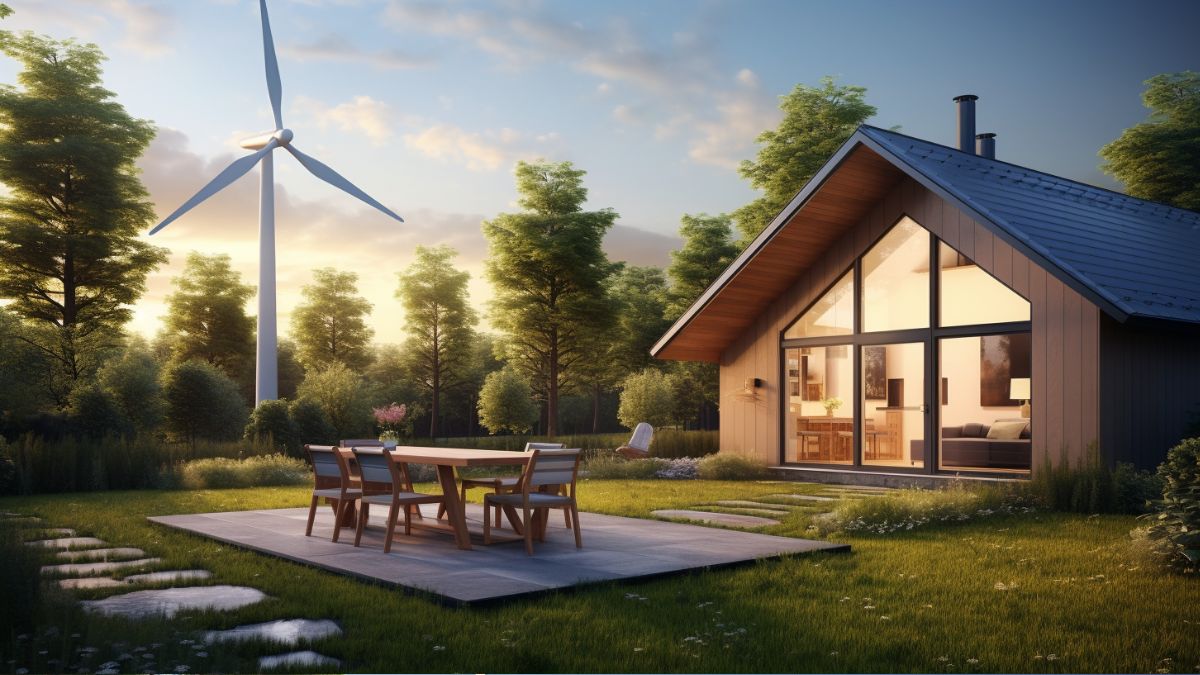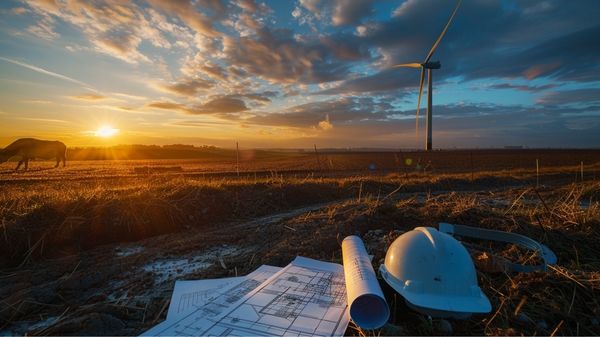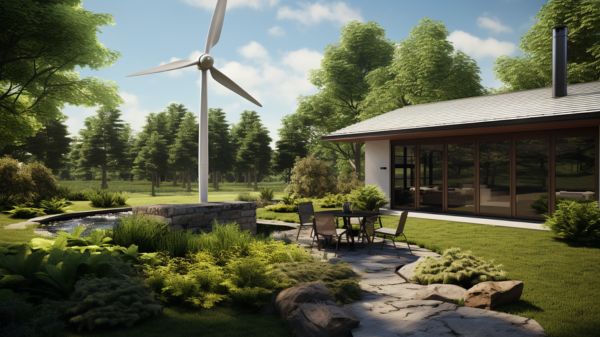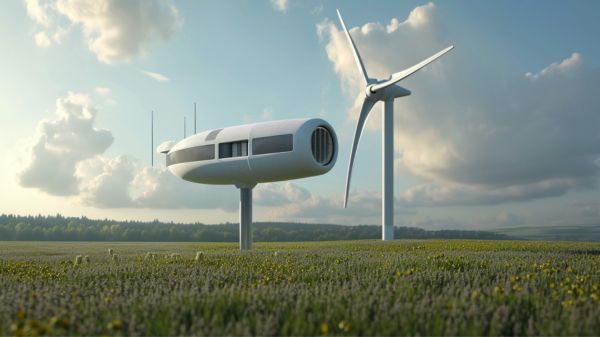Did you know that small wind turbines can generate clean and renewable energy for your home? With the increasing demand for sustainable solutions, small wind turbines are becoming a popular choice for homeowners. In this article, we will explore the suitability, cost, buying tips, and installation of small wind turbines for homes.
We will also discuss the ideal locations, wind speed requirements, and potential obstructions for these turbines. So, get ready to harness the power of the wind and reduce your carbon footprint!
Key Takeaways
- Small wind turbines for homes are a renewable energy solution that can help reduce reliance on the grid and lower electricity bills.
- The cost of small home wind turbines can vary widely, but long-term energy savings can outweigh upfront costs.
- When buying and choosing a small wind turbine, it is important to assess energy needs, average wind speed in the area, and budget, and to consider features, efficiency, and reliability.
- Sizing, installation, and maintenance are crucial for optimal performance of small wind turbines.
Overview and Suitability of Small Wind Turbines
Do you want to learn about the overview and suitability of small wind turbines for your home?
Small wind turbines for homes are a renewable energy solution that can help you reduce your reliance on the grid and lower your electricity bills. These turbines are typically mounted on a tower or rooftop and use the power of the wind to generate electricity.
The suitability of small wind turbines depends on various factors, including the average wind speed in your area, the size of your property, and local regulations. Before installing a small wind turbine, it’s important to conduct a thorough site assessment to determine if your location is suitable for harnessing wind energy.
Additionally, it’s important to consider the upfront cost, maintenance requirements, and potential noise and visual impacts of installing a small wind turbine.
Cost of Small Wind Turbines for Homes
You can compare the cost of small wind turbines and weigh them against their potential energy savings. Small wind turbines for homes have become an increasingly popular option for those looking to reduce their reliance on traditional energy sources and save money in the long run.
When considering the cost of a small wind turbine for your home, it’s important to take into account factors such as the size and capacity of the turbine, installation costs, maintenance expenses, and the potential energy savings it can provide. On average, a small home wind turbine can cost anywhere from $10,000 to $70,000, depending on these factors.
However, it’s essential to remember that while the initial investment may seem high, the long-term energy savings can often outweigh the upfront costs. Additionally, various government incentives and rebates are available to further reduce the financial burden of installing a small wind turbine for your home.
Related Post: Renewable Energy Made Easy: DIY Vertical Axis Wind Turbine.
Buying and Choosing Small Wind Turbines for Homes
If you’re considering buying a small wind turbine, it’s important to research the different options and choose one that best fits your energy needs and budget. Small wind turbines can be a great addition to your home, providing renewable energy and potentially reducing your electricity bills.
Here are some factors to consider when buying and choosing a small wind turbine for your home:
Energy needs
- Assess your energy consumption and determine how much electricity you want the turbine to generate.
- Consider the average wind speed in your area to ensure the turbine will be able to produce enough power.
Budget
- Determine your budget for purchasing and installing the turbine.
- Compare the costs of different turbines, including any additional expenses for installation and maintenance.
Top 5 Best Small Wind Turbines for Homes
If you’re looking for the best small wind turbines for your home, there are several options to consider.
The Missouri General Freedom II Wind Turbine is a popular choice known for its durability and efficiency. HappyBuy Wind Turbine (24 V) is another reliable option that offers high power output. EOLO Small Vertical Axis Wind Turbine, SHZOND Wind Generator, and Tumo-Int Wind Turbine are also worth considering.
Each of these turbines has its own unique features and advantages, so it’s important to research and compare them to find the best fit for your needs.
1. Missouri General Freedom II Wind Turbine

The Missouri General Freedom II Wind Turbine is one of the best small wind turbines on the market. With its reliable performance and efficient design, it’s a great option for homeowners looking to harness the power of wind energy.
The turbine has a maximum power output of 2000 watts, making it suitable for residential use. It features a durable construction, with a corrosion-resistant body and a sturdy rotor. The Freedom II Wind Turbine also comes equipped with a built-in voltage regulator, ensuring a stable output of electricity.
Pros:
- Reliable performance and efficient design
- Maximum power output of 2000 watts
- Durable construction with corrosion-resistant body
- Equipped with a built-in voltage regulator
Cons:
- May require additional equipment for installation
- Requires a minimum wind speed of 9 mph to start generating power
- Some users have reported noise issues during operation
Product Specs:
- Maximum Power Output: 2000 watts
- Minimum Wind Speed: 9 mph
- Construction: Corrosion-resistant body
- Additional Features: Built-in voltage regulator
2. HappyBuy Wind Turbine (24 V)

You should consider the Happybuy Wind Turbine (24 V) as one of the best small wind turbines available. This wind turbine is designed to harness wind power and convert it into usable electricity for your home. With a voltage of 24 V, it’s suitable for small-scale applications and can generate power even in low wind conditions.
The Happybuy Wind Turbine boasts several impressive features that make it a top choice for homeowners. Firstly, it has a high output efficiency, ensuring maximum power generation from the wind. Additionally, it’s made of durable materials that can withstand harsh weather conditions, ensuring longevity and reliability. The turbine also operates quietly, making it an ideal option for residential areas.
However, there are a few drawbacks to consider. The Happybuy Wind Turbine has a relatively low power output compared to larger turbines, which may limit its ability to meet high energy demands. Additionally, some users have reported challenges with installation and maintenance.
Overall, the Happybuy Wind Turbine (24 V) offers a reliable and efficient solution for generating electricity from wind power. Its durability, quiet operation, and high output efficiency make it a great choice for homeowners looking to harness renewable energy and reduce their carbon footprint.
Product Specs:
- Voltage: 24 V
- Output Efficiency: High
- Materials: Durable and weather-resistant
Pros:
- High output efficiency
- Durable and weather-resistant
- Quiet operation
Cons:
- Relatively low power output
- Installation and maintenance challenges reported by some users
3. EOLO Small Vertical Axis Wind Turbine

Consider investing in the EOLO Small Vertical Axis Wind Turbine, as it offers a compact design and reliable performance. This small vertical wind turbine is perfect for those looking to harness wind power on a small scale. Here are a few reasons why the EOLO turbine is a great choice:
Compact Design:
- The EOLO turbine’s small scale makes it ideal for residential use.
- Its vertical axis design allows for easy installation in tight spaces.
Reliable Performance:
- The small wind turbine motor ensures efficient energy conversion.
- The turbine’s generator produces a steady output of power.
Overall, the EOLO Small Vertical Axis Wind Turbine provides a practical solution for generating renewable energy at home. With its compact design and reliable performance, it’s a valuable investment for those seeking to reduce their carbon footprint and save on electricity costs.
4. SHZOND Wind Generator

Check out the SHZOND Wind Generator for a reliable and efficient small wind turbine option. This wind generator is designed to harness the power of the wind and convert it into clean, renewable energy for your home. With its compact size and high efficiency, it’s perfect for homeowners who want to reduce their carbon footprint and save on energy costs.
The SHZOND Wind Generator has a rated power of 400W and is capable of generating electricity in wind speeds as low as 2.5m/s. It features a three-blade design that maximizes energy output and a built-in controller that ensures safe and efficient operation. The generator is made of high-quality materials that are durable and resistant to corrosion, making it suitable for long-term use.
One of the main advantages of the SHZOND Wind Generator is its reliability. It’s designed to withstand harsh weather conditions and has a low noise level, making it suitable for residential areas. Additionally, it’s easy to install and requires minimal maintenance, making it a hassle-free option for homeowners.
However, there are a few drawbacks to consider. The SHZOND Wind Generator may not be suitable for areas with low wind speeds, as its efficiency is optimized for moderate to high wind conditions. Additionally, it may not be as powerful as larger wind turbines, so it may not be able to meet the energy needs of larger households.
In summary, the SHZOND Wind Generator is a reliable and efficient option for homeowners looking to harness the power of the wind. With its compact size, high efficiency, and ease of installation, it’s a practical choice for those who want to reduce their reliance on traditional energy sources.
Product Specs:
- Rated Power: 400W
- Minimum Wind Speed: 2.5m/s
- Blade Material: Nylon Fiber
- Controller Type: Built-in
- Noise Level: Low
Pros:
- Reliable and efficient
- Compact size
- Easy installation and maintenance
Cons:
- Not suitable for low wind speeds
- May not meet the energy needs of larger households
5. Tumo-Int Wind Turbine

The Tumo-Int Wind Turbine is considered one of the best options for small wind turbines. This turbine is highly regarded for its efficiency and reliability, making it a popular choice among homeowners looking to generate clean energy.
With a sleek design and advanced technology, the Tumo-Int Wind Turbine is capable of harnessing wind energy and converting it into electricity for your home. It has a compact size, making it suitable for residential areas where space is limited.
Additionally, the Tumo-Int Wind Turbine is designed to operate quietly, ensuring minimal disturbance to you and your neighbors. With its high performance and user-friendly features, this wind turbine is an excellent investment for those seeking to reduce their carbon footprint and save on energy costs.
Product Specs:
- Rated Power: 1000W
- Rated Voltage: 24V
- Blade Length: 1.3m
- Weight: 22kg
- Start-up Wind Speed: 2.5m/s
Pros:
- Highly efficient and reliable
- Compact size, suitable for residential areas
- Quiet operation
- Generates clean energy, reducing carbon footprint
- Cost-effective in the long run
Cons:
- Requires a minimum wind speed to start generating power
- Initial investment cost may be high for some
- Regular maintenance and monitoring required for optimal performance
Sizing and Installation of Small Wind Turbines
You need to carefully plan for the sizing and installation of small wind turbines in order to maximize their efficiency. Small scale wind turbines are a great option for homeowners looking to generate their own renewable energy.
Here are some key points to consider when it comes to sizing and installation:
Sizing
- Assess your energy needs: Determine how much electricity you consume on average to determine the appropriate size of the generator for your small wind turbine.
- Evaluate your wind resource: Analyze the wind speed and direction at your location to ensure that it’s suitable for generating enough power.
Installation
- Select the right location: Install the turbine in an area with unobstructed wind flow, away from tall buildings or trees that can create turbulence.
- Follow manufacturer guidelines: Adhere to the manufacturer’s recommendations for installation to ensure safety and optimal performance.
Maintenance of Small Wind Turbines for Homes
To ensure optimal performance, regularly inspect and clean the blades of your small wind turbine to prevent debris buildup. Debris accumulation on the blades can reduce the efficiency and output of your turbine.
Inspecting the blades every few months is recommended, or more frequently if you live in an area with high pollen, dust, or other airborne particles. Use a soft cloth or brush to gently remove any dirt or debris from the blades.
Be sure to check for any signs of damage or wear, such as cracks or chips, as this can affect the turbine’s performance. Additionally, it’s important to lubricate any moving parts according to the manufacturer’s recommendations.
Locations Ideal for Small Wind Turbines for Homes
Where else can small wind turbines be installed, and can they be effective in urban areas?
Small wind turbines are typically associated with rural areas, where there’s ample space and less obstruction for wind flow. However, with advancements in technology and design, small wind turbines can also be installed in urban areas.
Here are some potential locations for small wind turbines in urban areas:
- Rooftops: Installing small wind turbines on rooftops can take advantage of the strong wind currents at higher altitudes.
- Parks and Open Spaces: Placing small wind turbines in parks and open spaces can utilize the open areas and generate clean energy for nearby buildings.
- Vertical Axis Wind Turbines: These turbines can be installed on the sides of buildings, utilizing the vertical wind flow in urban canyons.
While small wind turbines may face challenges such as space limitations and potential noise concerns, they can still be effective in urban areas by supplementing the energy needs of buildings and reducing reliance on the grid.
Related Post: The Alpha 311 VAWT System: Innovative Vertical Wind Turbine.
Wind Speed for Small Wind Turbines for Homes
Although wind speed is a critical factor for the efficiency of small wind turbines, it can vary depending on the location and height at which they’re installed. Understanding the wind speed in your area is essential when considering the installation of a small wind turbine for your home.
Higher wind speeds generally result in more power generation, which can contribute to greater energy savings. The average wind speed at a specific location can be influenced by various factors such as topography, nearby obstructions, and local weather patterns.
Additionally, the height at which the turbine is installed can also impact wind speed, as wind tends to be stronger at higher altitudes. Therefore, it’s crucial to conduct a thorough analysis of your location and consult wind speed data to determine if a small wind turbine is a viable solution for your energy needs.
Obstructions and Zoning for Small Wind Turbines
You should be aware of the potential obstructions and zoning regulations that may affect the installation of small wind turbines for your home. Obstructions such as tall buildings, trees, or nearby structures can disrupt wind flow and reduce the effectiveness of the turbine.
Zoning regulations vary by location and may impose restrictions on the height, noise level, and setback requirements for wind turbines. It’s important to research and comply with these regulations to avoid any legal issues or fines.
Additionally, consulting with a professional installer can help determine the feasibility of installing a small wind turbine in your area. They can assess the local wind resources, evaluate potential obstructions, and guide you through the zoning process.
Open Ground Space for Small Wind Turbines
You can maximize the efficiency of small wind turbines by placing them in open ground space and utilizing the unobstructed wind flow. When small wind turbines are installed in areas with minimal obstacles, such as trees, buildings, or hills, they can generate more electricity and operate more effectively.
The unobstructed wind flow ensures that the turbines can capture the maximum amount of wind energy, leading to higher energy production. To illustrate the benefits of open ground space for small wind turbines, consider the following table:
| Location | Wind Turbine Efficiency |
|---|---|
| Open Ground Space | High |
| Residential Area | Moderate |
| Urban Environment | Low |
As shown in the table, placing small wind turbines in open ground space leads to higher efficiency compared to residential or urban environments. This is because open ground space allows for unimpeded wind flow, maximizing the turbine’s potential. So, if you want to maximize the efficiency of your small wind turbine, consider installing it in an open ground space with minimal obstructions.
Related Article: Renewable Energy Made Easy: DIY Vertical Axis Wind Turbine.
Frequently Asked Questions
How Do Small Wind Turbines Impact the Visual Aesthetics of a Home or Property?
When it comes to small wind turbines, you may be wondering about their impact on the visual aesthetics of your home or property. These turbines, while designed to harness wind energy, can vary in size and design.
Some models are sleek and modern, blending seamlessly into the surrounding environment. Others may be more noticeable, adding a unique architectural element to your property.
Ultimately, the visual impact of a small wind turbine will depend on its design, placement, and your personal preferences.
Are There Any Potential Health or Safety Concerns Associated With Small Wind Turbines?
Are you concerned about potential health or safety issues with small wind turbines? While there may be some risks associated with their installation and operation, it’s important to consider the benefits they can provide.
For example, a case study found that a small wind turbine installed on a home significantly reduced energy costs and carbon emissions. However, it’s crucial to ensure proper installation and maintenance to minimize any potential risks, such as noise pollution or structural damage.
Can Small Wind Turbines Be Integrated With Existing Solar Panel Systems?
Yes, small wind turbines can be integrated with existing solar panel systems. By combining the two technologies, you can maximize your renewable energy production.
The wind turbines can generate electricity when the sun isn’t shining, such as during cloudy days or at night. This allows for a more consistent and reliable power supply for your home.
Additionally, the combination of wind and solar power can help you offset your energy consumption and reduce your reliance on the grid.
What Kind of Noise Levels Can Be Expected From Small Wind Turbines?
When considering small wind turbines for your home, you may wonder about the noise levels they produce.
Generally, modern small wind turbines are designed to minimize noise. For example, a case study showed that a small wind turbine installed on a residential property in a suburban area produced noise levels similar to background traffic noise.
With advancements in technology and careful installation, you can expect small wind turbines to operate quietly and provide clean energy for your home.
Are There Any Government Incentives or Grants Available for Installing Small Wind Turbines in Residential Areas?
Yes, there are government incentives and grants available for installing small wind turbines in residential areas. These incentives and grants are designed to encourage the adoption of renewable energy sources and can provide financial support or tax benefits to offset the initial costs of installation.
The availability and specifics of these incentives and grants may vary from region to region. To determine the specific incentives and grants available in your area, it is important to research and consult local authorities.
Final Thought
Small wind turbines can be a cost-effective and sustainable solution for powering homes. By carefully considering factors such as cost, size, and wind speed, homeowners can choose the best turbine for their needs.
However, it’s important to assess the suitability of the location and ensure compliance with zoning regulations. Like a gentle breeze that whispers through the trees, small wind turbines can bring renewable energy into our homes.




